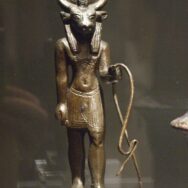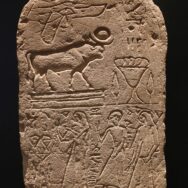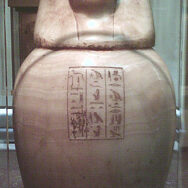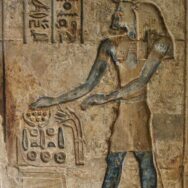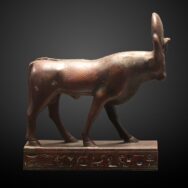Mnevis : The Bull God
Listen
At a glance
| Description | |
|---|---|
| Origin | Egyptian Mythology |
| Classification | Animals |
| Family Members | N/A |
| Region | Egypt |
| Associated With | Oracle, Sun |
Mnevis
Introduction
The Egyptian bull god known as Mnevis was regarded as the embodiment of the solar deity Re-Atum and was worshipped in the city of Heliopolis. He was typically depicted as either a piebald or black bull with a solar disc between its horns. According to Plutarch, the Memphite bull known as Merwer or Mnevis was second only to the Apis bull in importance. The movements of the Merwer were guided by divine will, and it was regarded as an oracle. The priests also claimed that it could also have been the father of the famous Apis.
Mnevis was one of several sacred bulls in ancient Egypt, along with Apis, Buchis, and Kafru. He was a symbol of strength, fertility, and solar power. He was also a link between heaven and earth, between gods and humans, between life and death. He was revered as a god in his own right, but also as an aspect of Atum-Ra, the supreme creator god.
Physical Traits
A number of living bulls were chosen by priests to be consecrated as Mnevis bulls, and these were chosen according to certain criteria. These animals had to have a black forehead or a white spot on their back. They also had to have double tails and a scarab-like mark under their tongue. At the heliopolis, the bull was housed in a special enclosure, where it was cared for and fed by priests. It was also granted two concubines. These are cows that represent Iusaaset and Hathor.
Family
The origins of the Mnevis cult can be traced back to the Old Kingdom, which dates back to around 2686 to 2181 BCE. In the Pyramid Texts, he was referred to as the “bull of Heliopolis.” He was also associated various solar deities such as Ra, Khepri, and Atum. The people believed that he was the soul of Ra and would accompany him as he flew across the sky. He was regarded as the heir apparent of Atum, and he was the physical embodiment of the deity’s creative power.
Other names
The origin and meaning of the name Mnevis is uncertain. Some scholars have suggested that it derives from the Egyptian word mnw, meaning “to stay” or “to endure”, implying that Mnevis was a symbol of stability and continuity. Others have proposed that it comes from the word mniw, meaning “to moan” or “to roar”, referring to the sound of the bull. In any case, Mnevis was also known by other names, such as Merwer (“great black”), Nemur (“the great one”), and Ka (“the bull of his mother”).
Powers and Abilities
The Mnevis bull was revered as a sacred animal and a living god. It was consulted as an oracle and was thought to communicate the divine will through its movements and sounds. It was also considered a mediator between the gods and the people, and a protector of the pharaoh. The Mnevis bull participated in various rituals and festivals, such as the sed festival, which celebrated the renewal of the pharaoh’s power. It was also honored with votive offerings and steles dedicated by devotees.
When the Mnevis bull died, it was mummified and buried with great pomp and ceremony in a special necropolis near Heliopolis. The burial site was called Bakhu (“the place of splendor”) or Shetayet (“the hidden place”). The mummy of the bull was placed in a wooden sarcophagus decorated with gold and precious stones. The sarcophagus was then placed in a stone coffin inside a vaulted chamber. The burial chamber was surrounded by a wall and guarded by statues of sphinxes and other animals. The burial complex also included chapels, storerooms, and priests’ quarters.
The cult of Mnevis declined after the New Kingdom (c. 1550-1070 BCE), when Heliopolis lost its prominence as a religious center. However, it continued to exist until the Roman period (c. 30 BCE-395 CE), when it was finally suppressed by Christianity. The remains of the Mnevis necropolis were discovered by archaeologists in the 19th century CE, but most of them have been destroyed or looted since then.
Modern Day Influence
Mnevis has recently been introduced across various movies, TV series and books as an important character in Egyptian mythology. Although the significance of Mnevis declined in the later years, the presence of teh character in movies like Gods or Egypt, has renewed interest in recent times.
Related Images
Frequently Asked Questions
What is lorem Ipsum?
I am text block. Click edit button to change this text. Lorem ipsum dolor sit amet, consectetur adipiscing elit. Ut elit tellus, luctus nec ullamcorper mattis, pulvinar dapibus leo.
What is lorem Ipsum?
I am text block. Click edit button to change this text. Lorem ipsum dolor sit amet, consectetur adipiscing elit. Ut elit tellus, luctus nec ullamcorper mattis, pulvinar dapibus leo.
What is lorem Ipsum?
I am text block. Click edit button to change this text. Lorem ipsum dolor sit amet, consectetur adipiscing elit. Ut elit tellus, luctus nec ullamcorper mattis, pulvinar dapibus leo.
What is lorem Ipsum?
I am text block. Click edit button to change this text. Lorem ipsum dolor sit amet, consectetur adipiscing elit. Ut elit tellus, luctus nec ullamcorper mattis, pulvinar dapibus leo.
What is lorem Ipsum?
I am text block. Click edit button to change this text. Lorem ipsum dolor sit amet, consectetur adipiscing elit. Ut elit tellus, luctus nec ullamcorper mattis, pulvinar dapibus leo.

